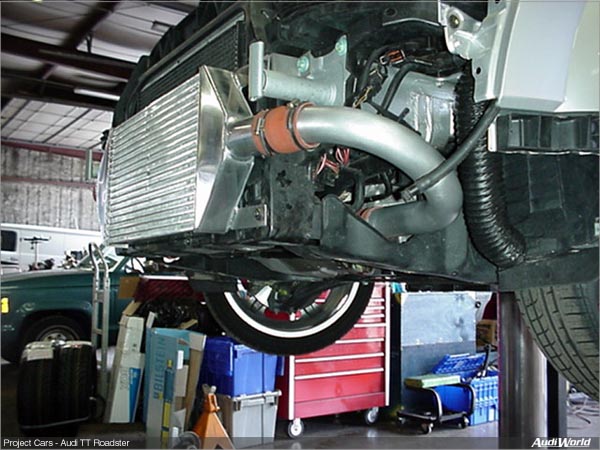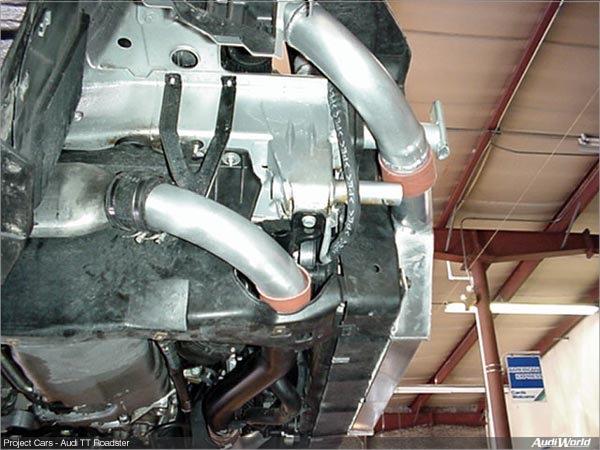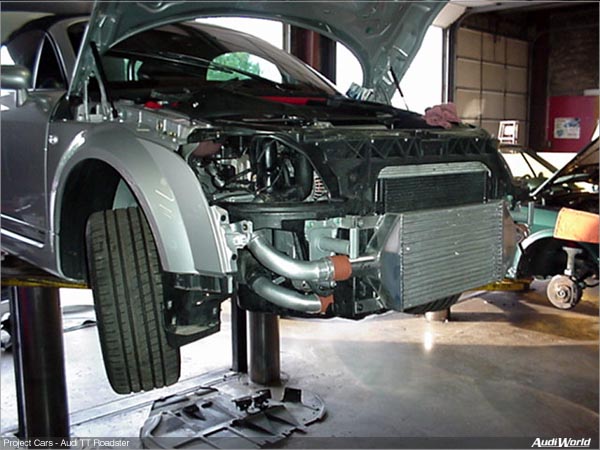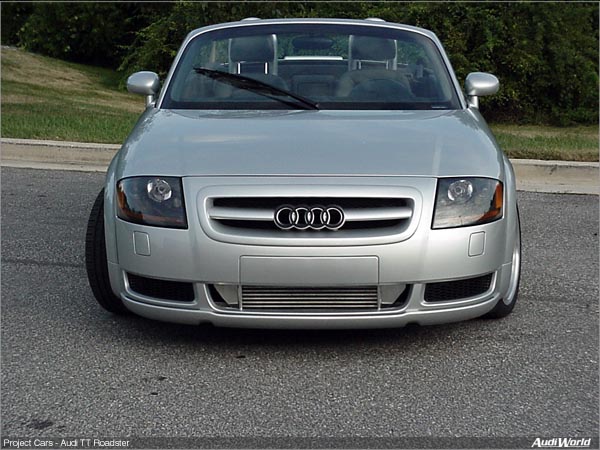The goal of ProjekTT from the beginning was to make this 180hp roadster a more capable performer in all areas. Although it could be argued that we should have started with a more capable 225-hp quattro car from the start, budget was an issue in choosing our particular TT and the 180-hp versions can be made just as potent, even if they aren't driving all four wheels.
Our original plan for the TT is to eventually add a Stage 3 upgrade that should include a new manifold, turbo and other ancillary parts to make this car much more capable of hanging with its 225 brethren, and also surpassing the performance of cars twice its price.
At the moment however, there is no Stage 3 kit yet available for the tranverse 1.8T. This forced us to rethink the steps in which the car was going to be modified to still achieve the same end result. We decided that if we were unable to purchase a Stage 3 kit, why not get the motor prepared for the future upgrade. One of the items that fell into this category was a larger intercooler mounted in the front of the car.
Once the decision was made to install a front mounted intercooler, we began researching the availability of a kit that would bolt up to the TT. Unfortunately, the TT is still relatively new to the aftermarket and there are not a lot of choices available.
We were only able to find two intercooler kits that were bolt on for the TT, one was for the 225-hp and one was for the 180-hp. While the 180-hp design was interesting, the kit for the 225-hp kit from Forge looked like a much better upgrade considering the plans we have for this motor.
We determined that, because of Audi's part sharing design, all mounting points for the 225-hp intercooler would be the same, though the plumbing would have to be custom fabricated in order for it to operate properly.
A quick call to Stratmosphere helped us learn quite a bit more about the UK-based company known as Forge Motorsport. Since the intercooler that Forge offers is designed for the 225-hp, we wanted to know if they would be willing to sell us the core only, so that we would not be forced to purchase anything that would not be used on the car. A few days later, Stratmosphere called and relayed a message that Forge would be very interested in seeing someone install the kit on a 180-hp car. Forge and Stratmosphere agreed to deliver the core only. The order was placed and couldn't wait for the UPS truck to arrive.
When the intercooler arrived two days later, we took it out of the packaging to take a look and make sure that nothing had been damaged in transit and, to be honest, we also wanted to sit and stare at it as it was such a great looking piece.
The intercooler is made of all aluminum with a core size of approximately 21" wide and 11" tall. This was one serious intercooler that would seem right at home on just about any serious high performance turbcharged automobile. This intercooler is truly designed to provide the largest surface area possible in order to maximize the cooling.
While anyone would be anxious to immediately install a new upgrade like this on their car, we were especially so as the intercooler's arrival was only one week before Waterfest 2001, one of the largest Volkswagen and Audi shows on the East Coast.
During our research period, we had contacted a local shop in Eldersburg, Maryland by the name of Motortechnik. This shop has built a reputation for fabricating quite a few custom turbo setups, including complete intercooler solutions.
By the time the intercooler arrived, we were prepared to provide as much information as we could, bringing along all of the pictures that we could find of the Forge intercooler installed on the 225-hp car in order to help Motortechnik visualize what needed to be done.
We also spent some time downloading some pictures of the stock plumbing differences between the 180-hp and 225-hp in order to see where everything was located and how we could use this to our benefit.
This research turned out to be a good start, allowing Motortechnik to design the system to work without having even taking of a single nut or bolt. Once they had worked out how all of the plumbing should be routed, the real work began.

It was determined early on in the design process that there would be no easy way to retain use of the headlight washers because of the placement of the inlet/outlet tubes located on the end tanks of the intercooler. This was considered an obstacle of sorts, though the washer's rare use combined with it virtually never being driven in bad weather, made it not really that tough a choice. We were willing to make the sacrifice in order to get the intercooler installed and working.
Had we really wished to retain use of the washers, Motortechnik could have made some more radical bends in the piping, though higher performance comes with the path of least resistance, which dictates the keeping of bends and the angles to a minimum.
With the front bumper removed, the intercooler was bolted into its new position so that the plumbing pieces could then begin to be fabricated. This process begins with a supply of aluminum tubing that comes in different shapes like elbows and straight lengths.
Motortechnik simply started taking the aluminum pieces and trial fitting them together by cutting them to the appropriate lengths and angles and tack welding them together not dissimilar to a jig saw puzzle. With all of the pieces tack welded and in place, everything was removed from the car and the plumbing was then seam welded.
Once all of the plumbing was completed and tested for correct fit, the only step that was left to perform was make the necessary silicone hose connections that would connect the new plumbing to the existing turbo outlet and throttle body. High quality race-spec silicone hose was used throughout the installation process in order to give us the most durable setup possible.

All of the heavy duty German hose clamps were tightened to make sure that we had a completely leak proof install throughout the whole system. With everything double and triple-checked, we lowered the lift and started the car to make sure there were no leaks under boost.
Everything seemed to be working properly and we had no detectable boost leaks. With this completed, it was time to put the finishing touches on the install. This included relocating the horns and the outside air temp sensor to a new location. The task turned out to be a very easy one as there is plenty of room for these elsewhere.
With everything under the skin complete and installed, it was time to replace the front end of the car and take it for a test run. We were quite anxious to go for a spin so we started the car and left it idle for a few minutes so that it would be at normal operating temperature.
In the meantime we took a few paces back to take a peek at the huge intercooler that was lurking behind the intake grill. We definitely liked what we saw and just then realized that this front mounted intercooler not only had the potential to increase the performance of the car, but it also had the potential to make this car look very intimidating. There is something about a big stonkin' intercooler really makes someone think twice about the cars potential.
While we were not expecting to feel any real performance gains at first, especially because it was around 70 degrees that evening and no other engine modifications had been made to raise horsepower, we were very interested in determining whether we had any noticeable turbo lag or pressure drop due to the size of the intercooler.
Our initial runs at an industrial park near Motortechnik relieved our concerns as there was very little change in the response of the tiny k03 turbo and our boost gauge was reading a peak boost of 10psi just as it had before the intercooler install.
This was good news as far as we were concerned because we had accomplished our goals of adding a front mounted intercooler that would be suitable for any future radical turbo upgrades without having any downsides in the meantime.
We've now driven the car for several weeks in a range of weather conditions and are very pleased with the results. This upgrade should play a key role in our future plans for the motor, and the fact that it looks darn cool underneath the TT's front spoiler air intake is just icing on the cake.

